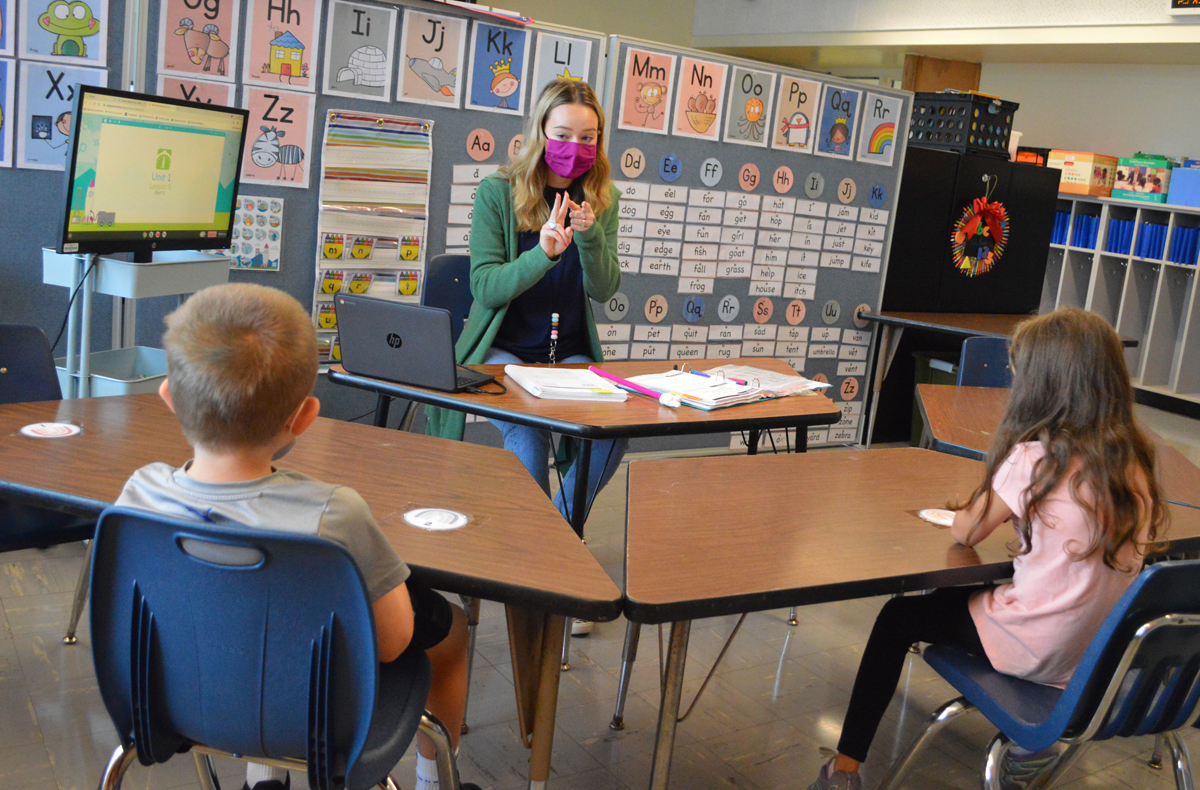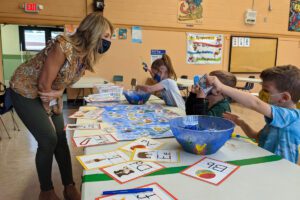
Intervention Specialist Megan Kenney teaching students during a recent lesson at Green Meadow Elementary School.
The following story is the second in a series about how the East Greenbush Central School District is utilizing COVID-19 relief funds from the federal government to support students affected by the pandemic. The story below will focus on the new K-3 Intervention Specialists who are helping to fill gaps due to learning loss caused by the pandemic.
When students returned to school in September, there was a sense of relief that all students in grades K-12 were back for full time in-person learning. It was the closest thing to normal since February 2020 before the pandemic started, and it was the result of an improved public health outlook and countless hours of planning.
But before the new school year even started, district administrators recognized some students would be returning with significant learning gaps caused by the pandemic.
The district took a proactive approach to combat that learning loss by utilizing federal COVID funds. It purchased a universal screener to evaluate reading, math and early literacy skills and it hired 10 K-3 Intervention Specialists to provide daily intervention services for elementary students who required extra help in those areas.
“We knew students would be coming into this school year with a wide range of academic needs, some with much greater needs for targeted instruction than in years past,” said Assistant Superintendent for Curriculum and Instruction James McHugh. “The universal screener allows us to consistently identify those students and our Intervention Specialists are able to deliver high quality intervention services that have the likely potential to yield tremendous benefits in our students’ academic progression moving forward.”
K-3 Intervention Specialists:
- MaryJane Hopeck (Bell Top)
- Lisa Rust and Kate Wargula (DPS)
- Kara Sullivan (Genet)
- Megan Kenney, Rebecca Cook and Kayla McHugh (Green Meadow)
- Jennifer Farrell, Caterina Marra and Kristin Callaghan (Red Mill)
Most students who receive intervention services meet in small groups of 2-4 students with a K-3 Intervention Specialist. They work on reading and math for 30 minutes every day in addition to their regular instruction in ELA/Early Literacy and Math.

Intervention Specialist MaryJane Hopeck guides students through a lesson at Bell Top.
MaryJane Hopeck, a new K-3 Intervention Specialist at Bell Top Elementary School, was hired this summer to help with this new initiative.
During a lesson last week, her students were playing a fishing game in which they matched upper and lowercase letters. Students would drop a fishing pole with a magnet on the end of it into a bowl of cards that had lowercase letters on them. A student would lift the pole out of the bowl and then match that lowercase letter with the correct uppercase letter on the table. The fun activity kept the students engaged while they learned the alphabet.
“Every day they learn a new letter and they get excited,” said Mrs. Hopeck.
Megan Kenney is a K-3 Intervention Specialist at Green Meadow Elementary School. She recently had two kindergarten students in her classroom looking at pictures on a screen and answering which picture was at the beginning, middle and end. During the activity, the screen showed a frog on the left, a snail in the middle and a snake on the right. Ms. Kenney asked a student, “Where is the frog? Is the frog at the beginning, the middle or the end?” When the student responded correctly, Ms. Kenney gave positive reinforcement saying “Awesome job!”
“With kindergarten it’s very foundational,” Ms. Kenney said. “We’re working on those foundation basic skills before we start moving into letter sounds and letter names and recognition.”

A kindergarten student answers a question during a recent lesson with Intervention Specialist Megan Kenney.
Ms. Kenney, Mrs. Hopeck and other Intervention Specialists have made use of a variety of learning resources such as Really Great Reading, Raz-Kids and guided reading books to help students build fundamentals for reading.
For the teachers who provide intervention services, including the new K-3 Intervention Specialists, AIS Reading Teachers and AIS Math Teachers, the progress they see in students is the greatest reward.
“I really enjoy watching the excitement when they get something and they’re proud of themselves,” said Mrs. Hopeck. “It helps build confidence which, then in turn when they go back into the classroom, they know they can do it.”
The East Greenbush Central School District was allocated $3,945,709 from the Coronavirus Response and Relief Supplemental Appropriations Act (CRRSA) and $3,092,281 from the American Rescue Plan (ARP) to support students and families affected by the pandemic. District administrators created plans for these funds which include investment in academic services, after school programs, mental health services, facility enhancements and technology purchases.
